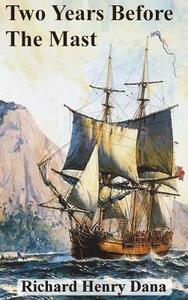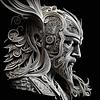Take a photo of a barcode or cover
adventurous
emotional
informative
reflective
relaxing
sad
tense
medium-paced
adventurous
challenging
informative
mysterious
reflective
slow-paced
adventurous
informative
reflective
medium-paced
Thank goodness I read the Patrick O'Brian books before this, as already being familiar with the nautical terms in the age of sail makes this a lovely read.
Rereading this book is a real pleasure. Dana was an extraordinarily good writer, his images so clear that it is easy to follow the complicated life aboard ship. It is of especial interest, I think, to California residents, as he spent most of his time sailing up and back along the coast, and thus describes what well-known cities were like during his time of visitation. One of his frequent stops was just a few miles from me--and the house still exists, now protected.
This was a hand-me-down book from my dad and as such, has been in my TBR shelves for years. Essentially, it is the diary of the author who, as a student at Harvard in the 1830s, suffered a bout of measles which affected his vision. He decided to enlist as a common sailor, planning not to write a rousing sea adventure tale but rather to expose many of the hardships faced by common sailors.
The author and the crew sailed from Boston, around Cape Horn to the early California coastal towns where they worked the California Hide trade, ultimately returning to Boston in what turned out to be a two year journey.
This could have been very dry material, as the author does spend quite a bit of time describing in detail the everyday life aboard the sailing ships. But he also offers his insights into the people he encounters, both his shipmates and the native peoples of California. The book is one of the few that exists about that time in California and with the onset of the gold rush in 1849 has become a valuable historical resource for that period. Herman Melville was also, reportedly heavily influenced by this book.
An interesting read, told in a narrative style but certainly an opportunity to gain some insight on sailing ships of that time and how they operated.
The author and the crew sailed from Boston, around Cape Horn to the early California coastal towns where they worked the California Hide trade, ultimately returning to Boston in what turned out to be a two year journey.
This could have been very dry material, as the author does spend quite a bit of time describing in detail the everyday life aboard the sailing ships. But he also offers his insights into the people he encounters, both his shipmates and the native peoples of California. The book is one of the few that exists about that time in California and with the onset of the gold rush in 1849 has become a valuable historical resource for that period. Herman Melville was also, reportedly heavily influenced by this book.
An interesting read, told in a narrative style but certainly an opportunity to gain some insight on sailing ships of that time and how they operated.
A Harvard University student's two-year sea voyage to Mexican California as a ordinary sailor.
Apparently a huge bestseller in its time. The author was a friend of Herman Melville, and gave Melville editorial help when Moby Dick was being written.
Mainly interesting because it's a 19th century nautical story written by someone who'd actually worked as an ordinary sailor and was highly literate. It's a straightforward story, told in a lively, straightforward way. There are lots of sections that seemed as poetic as anything I can remember in Moby Dick.
It got a bit boring in the last chapter or so, in the final stages of heading home to Boston. The edition I read also had a lot of epilogue and appendices, which were not as entertaining as the main body of the book, although some of this is reasonably interesting. For example, there is a description of his journey back to California 25 years after the events in the story after California had become a part of the United States, and San Francisco had been transformed from a single house into a city with stone buildings and over a 100,000 inhabitants.
Maybe not as good a book as Moby Dick, but very good, and it's non-fiction.
Apparently a huge bestseller in its time. The author was a friend of Herman Melville, and gave Melville editorial help when Moby Dick was being written.
Mainly interesting because it's a 19th century nautical story written by someone who'd actually worked as an ordinary sailor and was highly literate. It's a straightforward story, told in a lively, straightforward way. There are lots of sections that seemed as poetic as anything I can remember in Moby Dick.
It got a bit boring in the last chapter or so, in the final stages of heading home to Boston. The edition I read also had a lot of epilogue and appendices, which were not as entertaining as the main body of the book, although some of this is reasonably interesting. For example, there is a description of his journey back to California 25 years after the events in the story after California had become a part of the United States, and San Francisco had been transformed from a single house into a city with stone buildings and over a 100,000 inhabitants.
Maybe not as good a book as Moby Dick, but very good, and it's non-fiction.
adventurous
informative
adventurous
informative
reflective
slow-paced
The story itself is pretty incredible and a fantastic view into what live for a seaman was like in the age of sail ships. I particularly enjoyed the author's descriptions of a wild and largely un-inhabited California.
While I found the descriptions of California and the life on board a merchant ship incredibly interesting, the book seemed to drag on a bit for me. Despite the diagrams and initial Googling I did in the beginning of the book -- I was reading the Kindle edition, after "In the Heart of the Sea: The Tragedy of the Whaleship Essex" mentioned this book -- I never fully understood or remembered all the sailing terms, specifically in regard to the sails, which made it difficult at times to visualize what was going on. "[T]hree new top-sails, and new fore and main courses, jib, and fore top-mast stay-sail, [...] were bent, with a complete set of new earings [sic], robands and reef-points; and reef-tackles were rove to the sources, and spilling-lines to the top-sails. These, with new braces and clewlines, fore and aft, gave us a good suit of running rigging." I think they just put up some new gear?
I wouldn't categorize this book as a must-read, necessarily, but anyone interested in ships, naval history or what California was like before it was part of the United States would certainly enjoy it without regret (even if I found speed-reading through parts necessary).
While I found the descriptions of California and the life on board a merchant ship incredibly interesting, the book seemed to drag on a bit for me. Despite the diagrams and initial Googling I did in the beginning of the book -- I was reading the Kindle edition, after "In the Heart of the Sea: The Tragedy of the Whaleship Essex" mentioned this book -- I never fully understood or remembered all the sailing terms, specifically in regard to the sails, which made it difficult at times to visualize what was going on. "[T]hree new top-sails, and new fore and main courses, jib, and fore top-mast stay-sail, [...] were bent, with a complete set of new earings [sic], robands and reef-points; and reef-tackles were rove to the sources, and spilling-lines to the top-sails. These, with new braces and clewlines, fore and aft, gave us a good suit of running rigging." I think they just put up some new gear?
I wouldn't categorize this book as a must-read, necessarily, but anyone interested in ships, naval history or what California was like before it was part of the United States would certainly enjoy it without regret (even if I found speed-reading through parts necessary).





